“Unique, difficult, and kind of soothing.”
That is how Jillian Yong, a senior, described studio art’s latest project called abstract portraits.
At first sight, the project seemed simple; the students were to paint themselves from the neck up, then add an abstract background.
However, the project was actually a bit more complex.
“You can either start by drawing yourself from looking in a mirror or trace a photograph of yourself,” said Yong.
Yong chose to trace from a mirror, which she found difficult compared to tracing a photo.
For the second step, students were required to paint a brown underpainting of their face using the penciled out sketches they made.
Another student in studio art, sophomore Grace Li, said, “An underpainting allows the artist to create a foundation on their canvas. It gives contrast and tonal values to the painting.”
Next, students could either finish the portrait over the brown underpainting or continue directly to the abstract background.
While all students used oil paints to make the backgrounds, a variety of tools were used to spread the paint on the canvas.
“It was up to you how you put the paint on the canvas. Some people used cloth rags or even straws, but most used brushes I think,” said Yong.
Li used another tool, a palette knife, to make her background.
“It’s generally used to blend colors on a palette, however, it can also be used to blend colors on a canvas as well as give additional texture to the painting,” said Li.
In Li’s portrait, she is pictured surrounded by color: on the left, a cascade of red and gold is painted in a natural but haphazard way, as if the red and gold stripes of paint are torn pieces of tissue paper strewn atop the canvas. On the right, a wash of blue fans out from behind her head like a splash of water.
“I found that blues and greens worked well for darker shadows, and red was a nice addition to the skin’s lighter shadows. I liked that the project gave you freedom to do whatever you’d like with the background and the color usage,” said Li.
Overall, the students said they enjoyed the freedom of the project most.
Cynthia Hodges, who teaches studio art said, “[On the backgrounds] they could do anything they wanted, just to make everyone’s look different so it wouldn’t look like a high school classroom project.”
Although the students enjoyed the freedom, they did note Hodge’s lack of instruction on this particular project.
Yong said, “She didn’t really explain much about the backgrounds aside from, ‘Check Pinterest for ideas.’”
Hodges usually does an example of an art project for the class before they begin, then she’ll walk around and give advice.
“I didn’t do any demonstrations for the backgrounds because I wanted everybody to kind of experiment and figure out what they would like best,” said Hodges.
The paintings were often structured similarly, but the students used the full extent of their freedom to make their portraits individualized.
“I think it was really cool how each person’s painting was so unique to themselves. Even though it was obviously a self-portrait and had a person’s face on it, you could tell each painting was done by a different person,” said Yong.



